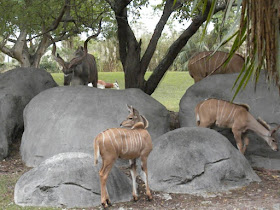You don't simply drop into the White Oak Conservation center on a whim, taking a Saturday visit with the family. Unlike other members of the
Conservation Centers for Species Survival, the facility is largely closed to the public. Special guided tours can be arranged, though they are only set up by appointment on certain days. The casual visitor would probably be more inclined to visit the Jacksonville Zoo, about an hour away, where a greater diversity of animals can be encountered in enclosures more conducive to viewing with much more ease and flexibility. For a person interested in wildlife management and conservation, however, a trip to White Oak is an interesting and enjoyable experience. In some ways, the entire tour is a behind-the-scenes peek at how modern zoos work to save species.

The history of the property, located on the St. Mary's River that divides Florida and Georgia, dates back to the 1760's. The land was used as a rice plantation around the time of the American Civil War, and some of the architecture from the era remains; while there, I saw a cheetah dozing alongside a shed that our guide said was built in the 1830's. Temporarily abandoned, it was purchased in the 1930's by the Gilman family. It was under the management of this family that the center began to work with endangered hoofed animals, first almost as a hobby, later with more scientific management. Purchased by Mark and Kimbra Walter in 2013, the center has continued its conservation work, dedicating itself to the breeding of endangered wildlife.
The center primarily works with endangered antelope, which are maintained in a series of large paddocks. The mild northern Florida climate works well for African species, and White Oak is home to flourishing herds of addra gazelle,
bongo,
gerenuk, giant eland, and roan antelope, among other species. Some of the antelope bred here have been sent back to Africa to participate in
reintroduction efforts in the range countries. While most of the breeding is done naturally, taking advantage of the large pastures that allow herd behavior, the center has also experimented with reproductive technology; for example, it was the first facility to produce gerenuk calves through artificial insemination, later resulting in second-generation AI offspring.
In addition to the antelope, White Oak boasts impressive herds of African buffalo, Grevy's zebra, Somali wild ass, giraffe, and
okapi. The later especially impressed me - I probably saw more okapi during my one day in White Oak than I have in my entire life. The shy rainforest animals were all maintained - individually or in pairs for breeding - in large, densely forest paddocks, where they were easily lost among the the undergrowth. The beautifully lightly-wooded giraffe yard also was spectacular - not just for the number of giraffes (including calves) present, but for the massive trees that dwarfed even the tallest giraffes.
White Oak is also home to three of the five species of rhino - white, black, and Indian. The white rhinos have been especially prolific, again likely due to their herd management. Many facilities have two or three white rhinos. White Oak has dozens. It's quite a sight to see mothers strolling around with their young calves trotting behind them, or to see three or four female resting in a row beside a mud wallow.
Rounding out the White Oak collection are a few birds in the form of
cassowary, cranes, and curassows, as well as a few carnivores -
maned wolves, tigers, and, especially, cheetahs (over 100 have been born here). While not housed here on a regular basis, White Oak also has rehab facilities for Florida panthers.
Again, White Oak is not a conventional zoo, and I think that a lot of my non-animal friends might not have enjoyed it nearly as much as I did. There is a lot less diversity of wildlife than you would see at many zoos, instead focusing on the number of individuals. Even I, I'll admit, was starting to get a little restless after my thirtieth white rhino. Also, because it's generally not open to the public and the emphasis is on breeding, there isn't spectacular viewing. I was a little frustrated at points when there were animals that I really wanted to see better or photograph but I couldn't because of the rows of wire fencing in the way or the distance.

With that in mind, when you stop thinking of White Oak as a zoo and start thinking of it as a conservation center, your appreciation of it changes entirely. It's so much more enjoyable to view it as something completely unique - a behind-the-scenes view at how endangered animals are being bred-back from the edge of extinction, and a chance to learn about how efforts undertaken here - or in
Front Royal, Virginia, or
Escondido, California, or Cumberland, Ohio - are helping to save critically endangered species around the globe. My tour at White Oak might not have given me a lot of great photo opportunities, and it only added one new species to my life list. It did, however, greatly expand my understanding and appreciation of the Conservation Centers for Species Survival.

























